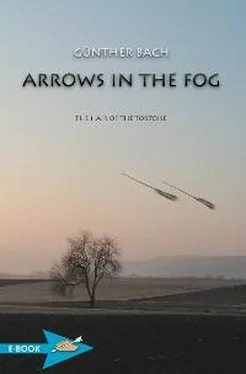Günther Bach - Arrows In The Fog
Здесь есть возможность читать онлайн «Günther Bach - Arrows In The Fog» — ознакомительный отрывок электронной книги совершенно бесплатно, а после прочтения отрывка купить полную версию. В некоторых случаях можно слушать аудио, скачать через торрент в формате fb2 и присутствует краткое содержание. Жанр: unrecognised, на английском языке. Описание произведения, (предисловие) а так же отзывы посетителей доступны на портале библиотеки ЛибКат.
- Название:Arrows In The Fog
- Автор:
- Жанр:
- Год:неизвестен
- ISBN:нет данных
- Рейтинг книги:5 / 5. Голосов: 1
-
Избранное:Добавить в избранное
- Отзывы:
-
Ваша оценка:
- 100
- 1
- 2
- 3
- 4
- 5
Arrows In The Fog: краткое содержание, описание и аннотация
Предлагаем к чтению аннотацию, описание, краткое содержание или предисловие (зависит от того, что написал сам автор книги «Arrows In The Fog»). Если вы не нашли необходимую информацию о книге — напишите в комментариях, мы постараемся отыскать её.
something that you merely know is there?
Rolf thinks that he hears Erhard’s voice saying:
“You must learn to see the invisible clearly!”
In this sequel of the archery novel «The horn of the hare» the story about the two friends continues.
15 years later: Germany is no longer divided and everything has changed, also Bärgers life and his shooting with the bow and arrow.
Arrows In The Fog — читать онлайн ознакомительный отрывок
Ниже представлен текст книги, разбитый по страницам. Система сохранения места последней прочитанной страницы, позволяет с удобством читать онлайн бесплатно книгу «Arrows In The Fog», без необходимости каждый раз заново искать на чём Вы остановились. Поставьте закладку, и сможете в любой момент перейти на страницу, на которой закончили чтение.
Интервал:
Закладка:
The outside walls had originally been white but were now somewhat gray on the windward side. Stains had been formed by water running along both sides of the lower sills, but all that was to be expected and was within the limits of normal wear and tear. Gutters and down spouts were intact. There was only one small birch, motionless in the late summer sun, growing near the south gable. Seeing it reminded Bärger to examine the roofing, and he climbed the echoing stair shaft to the third floor to look for an exit onto the roof. As he reached for the guard rail without thinking, he stirred up a cloud of gray dust.
He found the exit at the end of the corridor, steel rungs set into the wall, leading to a hatch in the ceiling.
It wasn’t hard to lift the hatch, which was secured by a chain, and a moment later Bärger stood on the roof and looked around. The roofing was a light colored clay coating and bore astonishingly few plants, if you ignored the isolated clumps of stonecrop and the little birch on the gable.
As far as he could see, there were no defects in the seams along the outer walls, nor around the flashing for the ventilation pipes and shafts. He noted the observation in his notebook. Then he put the notebook back in his pocket, sat down on a metal hood over a ventilation shaft, and looked out over the surrounding country.
The sparrow hawk was long gone, but another larger raptor had appeared, cruising over the woods.
How quiet it is here, thought Bärger.
He looked over at the cooling towers. Even at this height, they soared far above their bases like mathematical curves made real. Bärger knew that he would have to go over there, even though he couldn’t have said why. But first, he still had to inspect the turbine building.
After a final glance around, Bärger climbed back into the shaft, secured the hatch behind him and continued on his tour.
As expected, the access door in the gigantic sliding door of the turbine building was unlocked. He closed the heavy door behind him. The noise was like a loud shot in the empty chamber. Two doves took off from a steel beam with fluttering wings and flew side-by-side out of one of the open windows below the support for the traveling crane. Dust flickered in the beams of light, which fell into the huge room from the skylights.
There was nothing left of the machinery which must have once stood here. It looked as if earlier someone had planned to convert the building to a different use, but nothing had come of it. The walls were freshly whitewashed, and the tiled floor also showed no significant damage. Bärger looked for traces of the machinery mountings, but found nothing except for a few irregularities in the fit of the tiles. Even the traveling crane in the eastern peak seemed to be still in place. But his curiosity didn’t extend that far, not even to see what condition it was in.
Bärger noted his observations and also the conclusion that some effort had already been made to convert the building to a different use. I’ll make myself a present of the roof, he thought after glancing at his watch. The cooling towers were drawing him to them.
1PDS = Partei des Demockratischen Socializmus, successor to the East German SED Communist party.
3
Shortly after, he left the building and stepped out into the glaring sunlight, blinking. He crossed the courtyard and then made his way through the tall grass to the cooling towers, as if they were the real goal of his trip. As he approached, it became apparent that they stood on a small rise inside company land still surrounded by a tall, unbroken, wire fence. The traces of a deeply rutted dirt road were visible beneath the grass.
Bärger followed them to the artificial plateau, apparently raised for the construction of the towers.
Here too, it was apparent that any equipment had been removed a long time ago. In any case, the sunlit grass on the other side was clearly visible through the supporting struts, which he estimated as three stories high. The angle formed by the struts seemed to extend the hyperbolic curve of the cooling towers down to the ground. He looked up at the top edge of the tower. He felt dizzy, because the gigantic curved surface rising in front of him offered no stopping point for his eyes.
Bärger went closer, climbed up onto the foundation ring, and then stepped between the struts into the interior of the cooling tower.
In spite of the immense size of the chamber, where he suddenly found himself, he felt hemmed in and uneasy. It was suddenly clear to him that it was not in spite of, but because of its enormous size. The inhumanity of this gigantic funnel really came from the lack of any human dimension. He looked up to where the bell shaped shaft was open to the blue sky. The sun shone at a steep angle through the circular opening, and the sharply restricted beam of light lit the opposite inside wall all the way down to the floor. Bärger tried to complete the outline of this gleaming surface, determined by the deformation of a circle of light falling on the inside of a concrete bell, as a geometrical construction, but he was unsuccessful. It defied the abilities of his imagination.
He picked up his camera to get at least a two-dimensional image of this shape, but the field of view wasn’t wide enough to capture the entire picture. The thought that the size of this space would be beyond his ability to estimate reminded him of his laser range finder. As the side opposite to him lay in bright sunlight, Bärger took a couple of steps to one side, until he thought that he could make out the red reference dot in the tower’s own shadow on the other side. He whistled through his teeth. The display showed what his eyes could not – an exact measurement of 42.35 meters. He tried several times to measure the height, and finally decided to believe his third measurement, which indicated exactly 53 meters.
The height to the lower edge of the bell shaped wall, borne by the slanting struts, was close to four meters, far more than the usual height of a single story. He realized, surprised, that there was nothing else to measure, and that those dimensions would do nothing to help him come to grips with this space.
Even though he wasn’t sure why, he wrote down the measurements in his notebook, shoved his hands in the pockets of his jeans and began to pace around the edge of the cooling tower taking regular, equal strides. When he arrived back at his starting point, he had counted 220 paces, which roughly agreed with the measurement.
A small heap of gleaming, blue-black cinders, remnants from welding or more likely from cutting steel parts, lay in a small area of the smooth concrete, which formed a shallow basin inside the ring foundation. There were conspicuous places on the edges of the struts where they had been damaged by the removal of bulky pieces of cooling equipment. Aside from a broken wooden pallet and the mummified corpse of a rook, the gigantic space was empty.
Bärger walked slowly to the center, looked around in a circle and then up and suddenly had the feeling that the round hole up there leading into the sky was the real exit. A cloud passed over the edge of the tower and again he felt a slight dizziness, as he was unable to tell whether the cloud or the tower was moving. He positioned himself, standing where he thought the center point was, and lay down on his back staring up until his eyes hurt.
When he shut his eyes he heard the noise of the wind. He lay there long enough to become conscious of a new sensation. It seemed that he was becoming lighter and lighter, until he began to float. His body began to circle very slowly, while at the same time he rose higher and higher toward the opening into the light.
Bärger brought himself out of it. He shook his head vigorously and stood up bracing himself until the feeling of giddiness vanished. When he heard the sound of the car horn, repeated at short intervals, he realized what had brought him out of this peculiar waking dream. He had a feeling of relief as he walked slowly back toward the others already waiting by the cars, but just before the parking lot, he turned around again. The group of concrete giants stood against the blue sky so exactly angled from his position that the nearest tower completely concealed the one behind it, like an abstract symbol. What kind of symbol?
Читать дальшеИнтервал:
Закладка:
Похожие книги на «Arrows In The Fog»
Представляем Вашему вниманию похожие книги на «Arrows In The Fog» списком для выбора. Мы отобрали схожую по названию и смыслу литературу в надежде предоставить читателям больше вариантов отыскать новые, интересные, ещё непрочитанные произведения.
Обсуждение, отзывы о книге «Arrows In The Fog» и просто собственные мнения читателей. Оставьте ваши комментарии, напишите, что Вы думаете о произведении, его смысле или главных героях. Укажите что конкретно понравилось, а что нет, и почему Вы так считаете.









